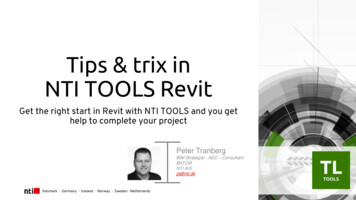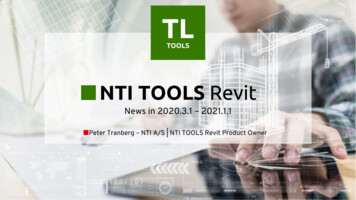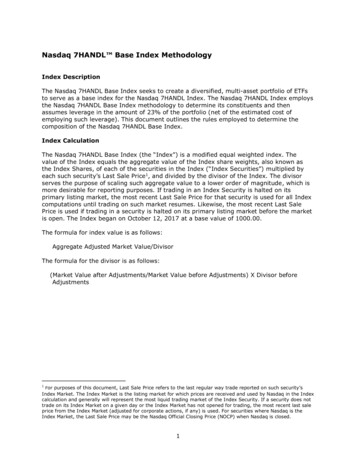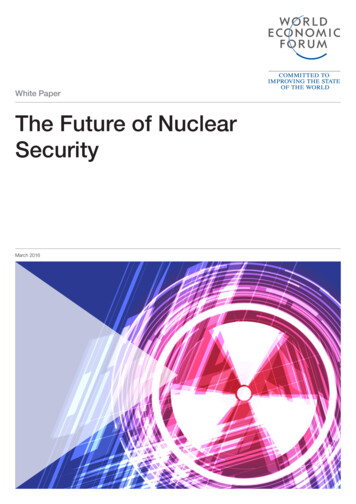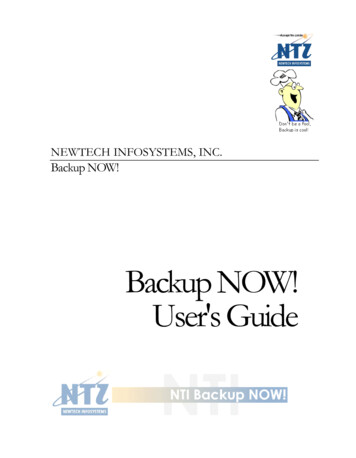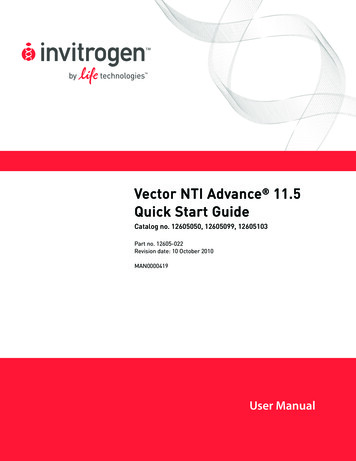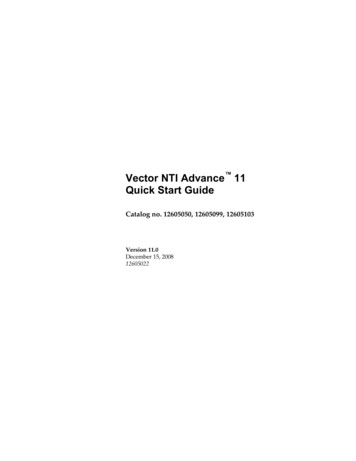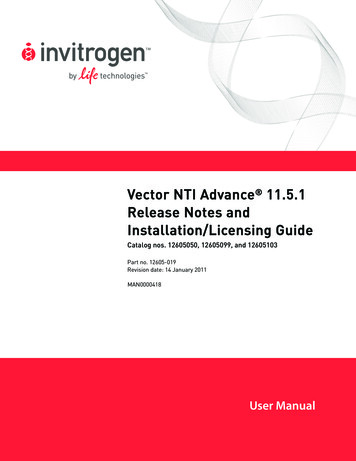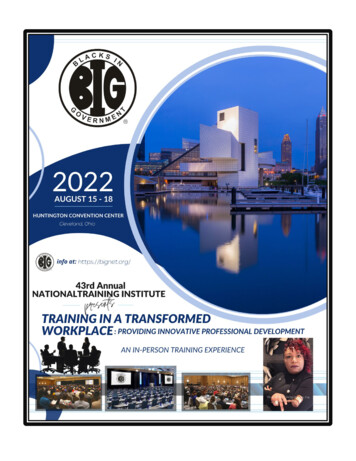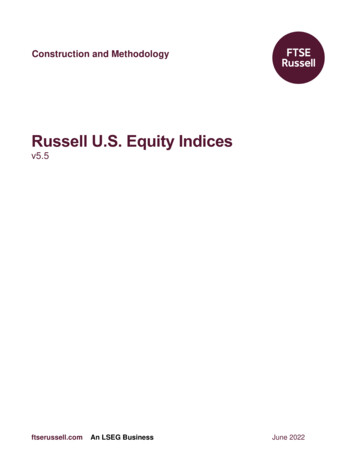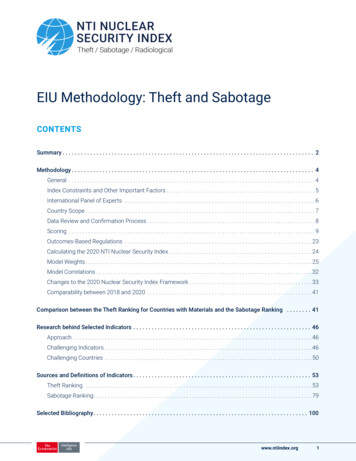
Transcription
NTI NUCLEARSECURITY INDEXTheft / Sabotage / RadiologicalEIU Methodology: Theft and SabotageCONTENTSSummary . . . . . . . . . . . . . . . . . . . . . . . . . . . . . . . . . . . . . . . . . . . . . . . . . . . . . . . . . . . . . . . . . . . . . . . . . . . . . . . . . . 2Methodology . . . . . . . . . . . . . . . . . . . . . . . . . . . . . . . . . . . . . . . . . . . . . . . . . . . . . . . . . . . . . . . . . . . . . . . . . . . . . . . 4General . . . . . . . . . . . . . . . . . . . . . . . . . . . . . . . . . . . . . . . . . . . . . . . . . . . . . . . . . . . . . . . . . . . . . . . . . . . . . . . . . . . . . . . . . 4Index Constraints and Other Important Factors . . . . . . . . . . . . . . . . . . . . . . . . . . . . . . . . . . . . . . . . . . . . . . . . . . . . . . 5International Panel of Experts . . . . . . . . . . . . . . . . . . . . . . . . . . . . . . . . . . . . . . . . . . . . . . . . . . . . . . . . . . . . . . . . . . . . . 6Country Scope . . . . . . . . . . . . . . . . . . . . . . . . . . . . . . . . . . . . . . . . . . . . . . . . . . . . . . . . . . . . . . . . . . . . . . . . . . . . . . . . . . 7Data Review and Confirmation Process . . . . . . . . . . . . . . . . . . . . . . . . . . . . . . . . . . . . . . . . . . . . . . . . . . . . . . . . . . . . 8Scoring . . . . . . . . . . . . . . . . . . . . . . . . . . . . . . . . . . . . . . . . . . . . . . . . . . . . . . . . . . . . . . . . . . . . . . . . . . . . . . . . . . . . . . . . 9Outcomes-Based Regulations . . . . . . . . . . . . . . . . . . . . . . . . . . . . . . . . . . . . . . . . . . . . . . . . . . . . . . . . . . . . . . . . . . . 23Calculating the 2020 NTI Nuclear Security Index . . . . . . . . . . . . . . . . . . . . . . . . . . . . . . . . . . . . . . . . . . . . . . . . . . . 24Model Weights . . . . . . . . . . . . . . . . . . . . . . . . . . . . . . . . . . . . . . . . . . . . . . . . . . . . . . . . . . . . . . . . . . . . . . . . . . . . . . . . 25Model Correlations . . . . . . . . . . . . . . . . . . . . . . . . . . . . . . . . . . . . . . . . . . . . . . . . . . . . . . . . . . . . . . . . . . . . . . . . . . . . . 32Changes to the 2020 Nuclear Security Index Framework . . . . . . . . . . . . . . . . . . . . . . . . . . . . . . . . . . . . . . . . . . . 33Comparability between 2018 and 2020 . . . . . . . . . . . . . . . . . . . . . . . . . . . . . . . . . . . . . . . . . . . . . . . . . . . . . . . . . . . 41Comparison between the Theft Ranking for Countries with Materials and the Sabotage Ranking . . . . . . . . . 41Research behind Selected Indicators . . . . . . . . . . . . . . . . . . . . . . . . . . . . . . . . . . . . . . . . . . . . . . . . . . . . . . . . . . . 46Approach . . . . . . . . . . . . . . . . . . . . . . . . . . . . . . . . . . . . . . . . . . . . . . . . . . . . . . . . . . . . . . . . . . . . . . . . . . . . . . . . . . . . . 46Challenging Indicators . . . . . . . . . . . . . . . . . . . . . . . . . . . . . . . . . . . . . . . . . . . . . . . . . . . . . . . . . . . . . . . . . . . . . . . . . . 46Challenging Countries . . . . . . . . . . . . . . . . . . . . . . . . . . . . . . . . . . . . . . . . . . . . . . . . . . . . . . . . . . . . . . . . . . . . . . . . . . 50Sources and Definitions of Indicators . . . . . . . . . . . . . . . . . . . . . . . . . . . . . . . . . . . . . . . . . . . . . . . . . . . . . . . . . . 53Theft Ranking . . . . . . . . . . . . . . . . . . . . . . . . . . . . . . . . . . . . . . . . . . . . . . . . . . . . . . . . . . . . . . . . . . . . . . . . . . . . . . . . . 53Sabotage Ranking . . . . . . . . . . . . . . . . . . . . . . . . . . . . . . . . . . . . . . . . . . . . . . . . . . . . . . . . . . . . . . . . . . . . . . . . . . . . . 79Selected Bibliography . . . . . . . . . . . . . . . . . . . . . . . . . . . . . . . . . . . . . . . . . . . . . . . . . . . . . . . . . . . . . . . . . . . . . . 100www.ntiindex.org1
NTI NUCLEAR SECURITY INDEX / EIU MethodologySUMMARYTo gain a better understanding of current global nuclear security conditions, the Nuclear Threat Initiative (NTI)commissioned the Economist Intelligence Unit (EIU) to construct the latest edition of the NTI Nuclear SecurityIndex (the 2020 NTI Index). The 2020 NTI Index provides a country-level assessment of nuclear securityconditions in 175 countries plus Taiwan. It follows the release of four iterations of the NTI Index, in January2012, January 2014, January 2016, and September 2018.The 2020 NTI Index divides countries into three groups, each with independent rankings and assessments. Thefirst group of countries assessed in the Index includes the 22 countries with 1 kilogram or more of weaponsusable nuclear materials (theft ranking for countries with materials). This ranking assesses actions related tosecuring materials against theft. The second group of countries includes the 153 countries and Taiwan thathave less than 1 kilogram of or no weapons-usable nuclear materials but that could be used as safe havens,staging grounds, or transit points for illicit nuclear activities (theft ranking for countries without materials). Thisranking assesses actions related to supporting global nuclear security efforts. These first two groups assessnuclear materials security conditions since 2012. The third and final group includes the 46 countries andTaiwan with certain types of nuclear facilities, the sabotage of which could result in a significant radiologicalrelease with serious off-site health consequences (sabotage ranking). This ranking assesses actions related toprotecting nuclear facilities against sabotage. The first edition of the sabotage ranking was released in 2016.Nuclear security is particularly difficult to observe, both because of the legacy of secrecy associated withthe subject and because of the absence of quantitative performance indicators. To address the need foran objective, country-level assessment of nuclear security, the EIU developed a multidimensional analyticalframework, commonly known as a benchmarking index. A multidimensional framework is a useful way ofmeasuring performance that cannot be directly observed—for example, a country’s economic competitivenessor, in this case, a country’s nuclear security conditions. Indices, in such cases, are effective in several ways:(a) they can aggregate a wide range of related data and evaluate them in a consistent manner; (b) they cantrack outcomes over time; and (c) they can spur countries to improve performance, especially relative to othercountries in the index. Indices can therefore be a useful tool for stimulating public policy reforms. The goal ofthe NTI Index is not only to prompt improvements in national nuclear security policies and programs, but alsoto encourage international debate on the risks and other factors that affect the likelihood of a country losingcontrol of its weapons-usable nuclear materials or a country’s nuclear facilities being subject to an act ofsabotage.The 2020 NTI Index is again the result of collaboration between NTI and the EIU. The EIU researched themetrics captured in the NTI Index, paying particularly close attention to any changes to regulations or licensingconditions in a country. As a result of updates and revisions to the NTI Index framework since 2012, direct yearon-year comparisons would not have been possible. To allow for such comparisons, the EIU rescored countriesin the previous editions of the NTI Index using the updated 2020 framework and the data that would have beenavailable when research for those editions was conducted.In addition, the results from previous editions of the NTI Index were thoroughly reviewed and researchedagain to ensure accuracy. In a limited number of cases, research indicated that more information had becomeavailable, a relevant law or regulation had not been captured, or researchers disagreed on a score. In thoseinstances, the EIU revised the previous scores to reflect the most accurate data. Rescoring those select datapoints was necessary for the 2020 NTI Index to capture accurate year-on-year comparisons. Most of theresearch was conducted between July 2019 and March 2020, although data were updated as new informationbecame available until April 1, 2020.www.ntiindex.org2
NTI NUCLEAR SECURITY INDEX / EIU MethodologyNTI and the EIU once again drew on the expertise of highly respected nuclear security experts (the InternationalPanel of Experts) from nuclear-weapon and non-nuclear weapon states, from countries with and withoutmaterials, and from developed and developing nations to provide input on options for strengthening the 2020NTI Index.The categories in the theft ranking for countries with materials, as well as in the sabotage ranking, are thefollowing:1. Quantities and Sites,1 which captures the quantity of nuclear materials, the number of sites, thefrequency of transport in a particular country, and whether quantities are increasing or decreasing;2. Security and Control Measures, which encompasses the core activities related to the physicalprotection and accounting of weapons-usable nuclear materials, personnel and security infrastructure,cybersecurity, and security culture;3. Global Norms, which includes actions that contribute to a strengthened global nuclear securityarchitecture;4. Domestic Commitments and Capacity, which indicates how well a country has implemented itsinternational commitments and a country’s capacity to do so; and5. Risk Environment,2 which examines issues that can undermine nuclear security at the national level,such as political instability, absence of effective governance, corruption, or illicit activities by non-stateactors.The theft ranking for countries without materials consists of Categories 3, 4, and 5 from the theft ranking forcountries with materials.The research for both the theft ranking for countries with materials and the sabotage ranking primarilyconsidered regulatory requirements for security. Reviewing security at the facility or site level within eachcountry was impossible, not least because of national security concerns. Researching domestic regulationsalso posed a challenge: some countries do not make public the majority of their nuclear security regulations,and two countries in particular, Israel and North Korea, do not make any regulations public. Owing to theseresearch challenges, the EIU used a variety of techniques to score certain countries (see Research behindSelected Indicators).To limit the degree of subjectivity in these indicators, the EIU created subindicators that were, wheneverpossible, framed as a binary choice (yes or no, 1 or 0). For example, the EIU asked if a country has domesticregulations or licensing conditions that require nuclear facilities to have protection from a cyber attack. Ifa country does, it is awarded one point; if it does not, it scores a zero. A binary approach limits the risk ofsubjectivity and increases the likelihood that the same scores would be obtained by another set of researchers,a key measure of objectivity and analytical rigor. If a binary approach was not appropriate, the research teamprovided a qualitative scoring approach.Despite the care taken in designing these measures, no index of this kind can be perfect. Some countries areparticularly non-transparent in matters of nuclear security. In those cases, the EIU scored indicators usingexpert judgment or relied on proxy measures such as the sophistication of a country’s military operations,which was used to assess how well weapons-usable nuclear materials and nuclear facilities are protected incountries where the military is primarily responsible for that protection.12Category 1 in the sabotage ranking does not include Quantities and is called Number of Sites.This category was named Societal Factors in the 2012 NTI Index.www.ntiindex.org3
NTI NUCLEAR SECURITY INDEX / EIU MethodologyThe indicators in the 2020 NTI Index are embedded in an interactive data model (available as an Excel workbookat www.ntiindex.org) that offers a wide range of analytical tools, allowing a deeper investigation of measuresof nuclear security globally. For example, users can filter countries by region or by membership in internationalorganizations or multilateral initiatives. A user can compare directly two or more countries and can examinecorrelations between indicators. Individual country profiles are also included in the 2020 NTI Index model,permitting a deeper dive into the nuclear security conditions in a given country. The weights assigned to eachindicator can be changed to reflect different assumptions about the importance of categories and indicators.Finally, the model allows scores to be benchmarked against external factors that may potentially influencenuclear security. For example, the results of the theft ranking for countries with materials correlate well withregulatory quality (as measured by the World Bank’s Worldwide Governance Indicators) and with those that aremost at peace (as measured by the 2019 Global Peace Index).METHODOLOGYGeneralThe 2020 NTI Index includes three separate rankings. The first ranking assesses the nuclear materials securityconditions in 22 countries that have 1 kilogram or more of weapons-usable nuclear materials (theft ranking forcountries with materials). This ranking assesses actions related to securing materials against theft. The rankinghas 73 subindicators used to construct 21 indicators across five categories. The scope of the theft ranking forcountries with materials includes highly enriched uranium (HEU), including spent fuel; separated plutonium; andplutonium in unirradiated mixed oxide fuel (MOX). A second, separate ranking assesses the nuclear materialssecurity conditions in 153 countries and Taiwan that have less than 1 kilogram of or no weapons-usable nuclearmaterials but that could be used as safe havens, staging grounds, or transit routes (theft ranking for countrieswithout materials).3 This ranking assesses actions related to supporting global nuclear security efforts. Thenumber of countries in the theft ranking for countries without materials was initially determined by the scopeof EIU’s Risk Briefing service.4 The ranking for countries without materials has 29 subindicators across nineindicators and three categories, which is a subset of those included in the ranking for countries with materials.Finally, the third ranking assesses nuclear security conditions in 46 countries and Taiwan5 with certain typesof nuclear facilities, the sabotage of which could lead to a significant radiological release with serious off-sitehealth consequences (sabotage ranking).6 This ranking assesses actions related to protecting nuclear facilitiesagainst sabotage. The sabotage ranking has 18 indicators and 66 subindicators across five categories.The overall score (0–100) for each country in each ranking is a weighted sum of the categories included in thatranking. Each category is scored on a scale from 0 to 100, where 100 represents the most favorable nuclearsecurity conditions and 0 represents the least favorable conditions. A score of 100 in the ranking does notindicate that a country has perfect nuclear security conditions, and likewise a score of 0 does not mean thata country has no security; instead, the scores of 100 and 0 represent the highest or lowest possible score,respectively, as measured by the NTI Index criteria. Each category score is normalized on the basis of the sumsof underlying indicators and subindicators, and a weight is then applied. Weights are based on input from the3456NTI recognizes that some states may have gram quantities of weapons-usable nuclear materials in multiple locations, which added together maybring totals to more than 1 kilogram. For the purposes of the NTI Index and the need to rely on publicly available information, those states aregrouped with states that have no weapons-usable nuclear materials.The EIU’s Risk Briefing service provides forecasts, alerts, background studies, and data covering a wide range of risk factors across 180 countries.The service is updated regularly in response to events that affect the assessment of operating risk in a particular country.Taiwan is included in the theft ranking for countries without nuclear materials and the sabotage ranking. Given Taiwan’s status, this Methodologydescribes the number of countries in the NTI Index as “153 countries and Taiwan” and “46 countries and Taiwan” in the theft ranking for countrieswithout materials and the sabotage ranking, respectively. Further references to numbers of countries in this Methodology include Taiwan.These nuclear facilities are the following: operating nuclear power reactors or nuclear power reactors that have been shut down within the lastfive years; research reactors with a capacity of 2 megawatts or greater; reprocessing facilities; and spent fuel pools, only if the fuel has beendischarged in the last five years and is not associated with an operating reactor.www.ntiindex.org4
NTI NUCLEAR SECURITY INDEX / EIU MethodologyInternational Panel of Experts and reflect the relative importance and relevance of each indicator and category.These weights differ across the three rankings to reflect how security priorities may be different in countrieswith or without weapons-usable nuclear materials and in countries with nuclear facilities. Although each modeldisplays by default the weights selected by the International Panel of Experts, a user can manually change theweights to see how different priorities might affect the scores and ranks.The framework and the number of countries in each of the three rankings have changed repeatedly since theIndex’s inception in 2012. For example, since 2012 the NTI Index theft ranking for countries with materials hasassessed the following:› 2012: 32 countries with weapons-usable nuclear materials across 18 indicators› 2014: 25 countries with weapons-usable nuclear materials across 19 indicators› 2016: 24 countries with weapons-usable nuclear materials across 20 indicators› 2018: 22 countries with weapons-usable nuclear materials across 20 indicators› 2020: 22 countries with weapons-usable nuclear materials across 21 indicatorsThe steady decline in the number of countries within the theft ranking for countries with materials between2012 and 2018 reflects the removal of all or most of such materials from the territories of 10 countries.7 TheNTI Index sabotage ranking assesses 47 countries against 18 indicators in 2020. The number of countriesincreased by two since 2018 as a result of construction of nuclear facilities in Jordan and the United ArabEmirates.Index Constraints and Other Important FactorsIn producing the NTI Index, the EIU relied on publicly available sources, such as laws and regulations, to reachinitial scoring conclusions. The research team gathered data from the following types of sources:› Primary legal texts and legal reports› Government publications and reports› Academic publications and reports› Websites of government authorities, international organizations, and non-governmental organizations› EIU country rankings and reports (specifically Risk Briefing and the Business Environment Ranking)› Local and international news media reportsSee Selected Bibliography for more information on central sources.The emphasis on publicly available sources has the benefit of creating a transparent and repeatablemethodology, but it also presents some challenges. For example, regulations and other requirements fornuclear security are sometimes classified. In cases where no public information was available, those countrieswere queried about the status of their regulations or licensing conditions as part of the data confirmationprocess. These countries could then choose whether to provide additional insight into their regulatoryrequirements, which could then be considered in making a final scoring decision.7Austria, the Czech Republic, Hungary, Mexico, Sweden, Ukraine, and Vietnam removed all or most of their materials between the release of the2012 NTI Index and the release of the 2014 NTI Index. Uzbekistan eliminated its stock of weapons-usable nuclear materials between the releaseof the 2014 NTI Index and the release of the 2016 Index. Argentina and Poland removed all or most of their materials following the release of the2016 Index.www.ntiindex.org5
NTI NUCLEAR SECURITY INDEX / EIU MethodologyIn cases where countries are particularly non-transparent and chose not to respond to data confirmationqueries, scores were assigned on the basis of a proxy indicator or the country was given a score of 0. Theabsence of information on nuclear security reduces public and international confidence in the securitymeasures countries are taking; thus, it is appropriate for those countries that do not make their regulationspublicly available to receive low scores.Although facility-level assessments would provide important ground-truth information, this level of granularityis not currently possible because of the sensitive nature of specific security arrangements. As a result, the NTIIndex relies instead on the assumption that a country with the appropriate laws and regulations in place is morelikely to have sound security procedures at each nuclear facility than is a country without appropriate laws andregulations.Additionally, the NTI Index includes “indicators” of security conditions and not the complete set of good securitypractices that nuclear faculties should employ to protect against theft of weapons-usable nuclear materials orsabotage of nuclear facilities. For example, information regarding the types of locking mechanisms, surveillancesystems, thickness of walls, and so forth, is not publicly available for security reasons. The exclusion of specificsecurity practices from the NTI Index does not reflect their lack of importance but instead reflects the researchconstraints of the NTI Index.Finally, please note that the NTI Nuclear Security Index does not directly address proliferation risks, smugglingor illicit trafficking, disarmament, or nuclear safety.International Panel of ExpertsAs in previous years, NTI and the EIU drew on the expertise of highly respected nuclear security experts (theInternational Panel of Experts) from nuclear-armed and non-nuclear armed states, from countries with andwithout materials, and from developed and developing nations, to provide input on options for strengthening the2020 NTI Index. The first meeting of the panel included discussions around the addition and removal of severalsubindicators, the development of a new Security Culture indicator, and the best method to promote progresson nuclear security in the absence of the Nuclear Security Summit process. The second meeting of the panelwas to provide input on weighting.In addition to convening the meetings of the International Panel of Experts, NTI and EIU also convened anothergroup of experts to develop a new approach to measuring the threat of terrorism. The EIU also received expertguidance from technical advisors on the panel throughout the research process. These technical advisorshelped the EIU modify and refine indicators to capture key elements of nuclear security and provided insightsinto the more technical parts of the research.www.ntiindex.org6
NTI NUCLEAR SECURITY INDEX / EIU MethodologyCountry ScopeBy reviewing recent reports pertaining to quantities of nuclear materials and taking into account recentdevelopments, the EIU identified the following 22 countries (listed in alphabetical order) as having 1 kilogram ormore of HEU (including spent fuel), separated plutonium, or plutonium content in unirradiated th KoreaNorwayPakistanRussiaSouth AfricaSwitzerlandUnited KingdomUnited StatesThe 2020 NTI Index also assesses the following 154 countries (listed in alphabetical order) that have less than1 kilogram of weapons-usable nuclear materials or no weapons-usable nuclear rbadosBelizeBeninBhutanBoliviaBosnia and HerzegovinaBotswanaBrazilBruneiBulgariaBurkina FasoBurundiCambodiaCameroonCape VerdeCentral African RepublicChadChileColombiaComorosCongo (Brazzaville)Congo (DemocraticRepublic of)Costa RicaCôte d’IvoireCroatiaCubaCyprusCzech RepublicDenmarkDjiboutiDominican RepublicEcuadorEgyptEl SalvadorEquatorial amaicaJordanKenyaKuwaitKyrgyz negroMoroccoMozambiqueMyanmarNamibiaNepalNew ZealandNicaraguaNigerNigeriaOmanPanamaPapua New maniaRwandaSamoaSão Tomé and PríncipeSaudi ArabiaSenegalSerbiaSeychellesSierra LeoneSingaporeSlovakiaSloveniaSolomon IslandsSomaliaSouth KoreaSpainSri stanTanzaniawww.ntiindex.org7
NTI NUCLEAR SECURITY INDEX / EIU MethodologyThailandTimor-LesteTogoTongaTrinidad and TobagoTunisiaTurkeyTurkmenistanUgandaUkraineUnited Arab menZambiaZimbabweThe 2020 NTI Index also assesses the following 47 countries (listed in alphabetical order) with nuclear facilities,the sabotage of which could result in a significant radiological release with serious off-site health consequences.Note that these 47 countries with nuclear facilities include 20 of the countries in the theft ranking for countrieswith materials and 26 countries and Taiwan that are in the theft ranking for countries without shBelgiumBrazilBulgariaCanadaChileChinaCzech therlandsNorth SloveniaSouth AfricaSouth KoreaSpainSwedenSwitzerlandTaiwanUkraineUnited Arab EmiratesUnited KingdomUnited StatesUzbekistanData Review and Confirmation ProcessAfter researching the indicators for each model, NTI and the EIU provided all 49 countries that are included inthe theft ranking for countries with materials, in the sabotage ranking, or in both with an opportunity to reviewand comment on the EIU’s preliminary results. The purpose of the data review and confirmation process was toensure the accuracy of the 2020 NTI Index data. The research team also recognized that some countries mightbe willing, upon request, to provide the EIU with more detailed information than is readily available to the public.To make this process as simple as possible, the EIU developed documents that presented the preliminaryscores for the 2020 NTI Index indicators. These forms allowed reviewers to either agree or disagree with thescore selected for their country and, if disagreeing, to offer an alternative answer and justification. The EIU usedthe submitted responses to reevaluate and potentially change a country’s scores. When the responses wereunclear, the EIU contacted individuals for clarification. Country representatives had three and a half months—from mid-November 2019 to March 1, 2020—to respond to the data review and confirmation request.Of the 49 countries, 27 officially responded to the data review and confirmation request. Those countrieswere Argentina, Australia, Belgium, Brazil, Canada, Chile, China, the Czech Republic, Finland, France, Germany,Hungary, Italy, Japan, Mexico, the Netherlands, Norway, Poland, Romania, Slovenia, South Korea, Sweden,Switzerland, Taiwan, the United Arab Emirates, the United Kingdom, and the United States.88Of the 27 countries that responded to the data confirmation, 12 are included in both the theft ranking for countries with materials and thesabotage ranking: Australia, Belgium, Canada, China, France, Germany, Japan, the Netherlands, Norway, Switzerland, the United Kingdom, and theUnited States. One response was from a country included only in the theft ranking for countries with materials: Italy. The remaining 14 responseswere from countries that are included only in the sabotage ranking: Argentina, Brazil, Chile, the Czech Republic, Finland, Hungary, Mex
The 2020 NTI Index is again the result of collaboration between NTI and the EIU . The EIU researched the metrics captured in the NTI Index, paying particularly close attention to any changes to regulations or licensing conditions in a country . As a result of updates and revisions to the NTI Index framework since 2012, direct year-
